Abandoned Farmland Extraction and Feature Analysis Based on Multi-Sensor Fused Normalized Difference Vegetation Index Time Series—A Case Study in Western Mianchi County
Abstract
1. Introduction
2. Materials and Methods
2.1. Study Area and Data Source
2.1.1. Study Area
2.1.2. Software
2.1.3. Data Source
2.1.4. Farmland Area Vectorization
2.1.5. Sample Point Acquisition
2.2. Methods
2.2.1. Data Processing
- Radiometric calibration and atmospheric correction: GF images were processed through the radiometric calibration tool “Radiometric Calibration” and the atmospheric correction tool “FLAASH Atmospheric Correction” in ENVI;
- Resample: GF-6 and Landsat 8 images in the near-infrared band and red band needed to be resampled to a resolution of 2 m using the cubic convolution method;
- Image registration: GF images and Landsat 8 images needed to be registered based on the GF-6 image from 26 November 2022;
- Band math: NDVI was calculated using GF-6 and Landsat 8 images, as follows:where NIR is the near-infrared band, and R is the red band of GF-6 or Landsat 8 images;
- STARFM spatial–temporal fusion: The NDVI computed from GF-6 and Landsat 8 images, obtained at a similar time, and the NDVI computed from a Landsat 8 image, obtained at another time without a GF-6 image covered, were selected to predict the GF-6 resolution-like (resolution of 2 m) NDVI.
2.2.2. STARFM
2.2.3. NDVI Difference Calculation
2.2.4. Abandoned Farmland Data Extraction
2.2.5. Accuracy Assessment
2.2.6. Farmland Abandonment Feature Analysis
3. Results
3.1. NDVI Temporal–Spatial Fusion
3.2. NDVI Difference Calculation
3.3. Abandoned Farmland Data Extraction
3.4. Extraction Result Accuracy and Comparison
3.5. Analysis of the Spatial Distribution of Abandoned Farmland
3.5.1. Overall Distribution of Abandoned Farmland in the Study Area
3.5.2. Feature Analysis of Abandoned Farmland
4. Discussion
4.1. Abandoned Farmland Data Extraction
4.2. Limitations and Prospects
4.3. Abandoned Farmland Feature Analysis
- The total area of abandoned farmland in the study area was approximately 12.73 square kilometers, and the overall abandonment rate was 5.43%. The kernel density analysis of the abandoned farmland showed that there were five highest-level density kernels distributed in the south, southeast, southwest, and central parts of the study area; these were generally distributed around the edge of the residential area in a ring shape;
- In the study area, the abandoned farmland and areas with high abandonment rates were mainly distributed in the elevation range of 400–800 m and the slope range of 0–10°. Although the abandonment rate in the areas with a high slope range (>25°) was significantly higher than the overall abandonment rate, the distribution of cultivated land in this area was very small. Therefore, the cultivated land and abandoned farmland, in general, were mainly distributed in the areas of low slope and low elevation. On the one hand, elevation and slope affect temperature, soil and water conservation, and light. On the other hand, they limit accessibility and large-scale mechanized agriculture; therefore, locations for farming are more likely to be chosen in areas with flat terrain and lower elevations;
- The distribution of abandoned farmland in the study area varies with the density of the road network. The area of abandoned land increases with the decrease in the road network density, but the abandonment rate decreases with the decrease in the road network density. Road network density directly affects the accessibility of transportation, and areas with high road network density are more suitable for large-scale mechanized agriculture and the transportation of crops and agricultural tools. At the same time, a highly dense road network also means the abandonment or even the occupation of the surrounding farmland;
- The area of abandoned farmland and the abandonment rate both increase with decreasing distance from residential areas. The distance from settlements is related to the expansion of construction land, and urbanization may lead to the abandonment of farmland near residential areas or even lead to a change in the land use type, resulting in an increase in the farmland abandonment rate.
5. Conclusions
- By fusing GF-6 and Landsat 8 images using STARFM to construct a dataset for time series analysis, the accuracy of the results can be effectively improved compared with the use of GF-6 data alone. This study is based on the difference in the NDVI values at different stages of the crop growth cycle, which is more effective for distinguishing between abandoned land and cultivated land. The accuracy of the results is higher than that obtained using SVM. The method is feasible, and the results are valid and reliable;
- On the basis of the extraction results, the features of abandoned farmland in the study area were analyzed. The results show that most of the farmland in Mianchi County is located in areas of terrain suitable for farming and that abandoned cultivated land is not as affected by elevation and slope as it is by the density of the road network and proximity to residential areas. Abandonment rates tend to be higher in areas with a high road density and close to residential areas. These results may help in the management of cropland abandonment and the regulation of farmland.
- Although the GF-6 data are of high resolution, they have fewer bands than other sensor-type data. Consequently, these data can only be analyzed by calculating several VIs for analysis, and only the NDVI was used in this study, which is a limitation for abandoned farmland data extraction;
- When high-resolution NDVI fusion is based on STARFM, the fused value of regions with abrupt NDVI changes is larger than the real value. The fusion accuracy decreases with the increase in the difference between the base date and the prediction date, which has an impact on the accuracy of the extraction results for abandoned farmland. Moreover, it is difficult to generalize the results to regions where cloudy and rainy weather persist for a long period of time.
Author Contributions
Funding
Institutional Review Board Statement
Informed Consent Statement
Data Availability Statement
Conflicts of Interest
References
- Huang, Y.; Li, F.; Xie, H. A Scientometrics Review on Farmland Abandonment Research. Land 2020, 9, 263. [Google Scholar] [CrossRef]
- Weissgerber, M.; Chanteloup, L.; Bonis, A. Perceptions of Vegetation Succession Following Agricultural Abandonment in the Massif Central Region (France). Landsc. Urban Plan. 2023, 234, 104717. [Google Scholar] [CrossRef]
- Chen, R.; Ye, C.; Cai, Y.; Xing, X.; Chen, Q. The Impact of Rural Out-Migration on Land Use Transition in China: Past, Present and Trend. Land use policy 2014, 40, 101–110. [Google Scholar] [CrossRef]
- Xu, D.; Deng, X.; Guo, S.; Liu, S. Labor Migration and Farmland Abandonment in Rural China: Empirical Results and Policy Implications. J. Environ. Manag. 2019, 232, 738–750. [Google Scholar] [CrossRef] [PubMed]
- Chaudhary, S.; Wang, Y.; Dixit, A.M.; Khanal, N.R.; Xu, P.; Fu, B.; Yan, K.; Liu, Q.; Lu, Y.; Li, M. A Synopsis of Farmland Abandonment and Its Driving Factors in Nepal. Land 2020, 9, 84. [Google Scholar] [CrossRef]
- Estel, S.; Kuemmerle, T.; Alcántara, C.; Levers, C.; Prishchepov, A.; Hostert, P. Mapping Farmland Abandonment and Recultivation across Europe Using MODIS NDVI Time Series. Remote Sens. Environ. 2015, 163, 312–325. [Google Scholar] [CrossRef]
- Li, L.; Pan, Y.; Zheng, R.; Liu, X. Understanding the Spatiotemporal Patterns of Seasonal, Annual, and Consecutive Farmland Abandonment in China with Time-Series MODIS Images during the Period 2005–2019. Land Degrad. Dev. 2022, 33, 1608–1625. [Google Scholar] [CrossRef]
- Qiu, Y.; Cao, G. The Heterogeneous Effects of Multilevel Location on Farmland Abandonment: A Village-Level Case Study in Tai’an City, China. Land 2022, 11, 1233. [Google Scholar] [CrossRef]
- Mianchi County People’s Government’s Notice on Further Strengthening and Standardizing the Post-Project Management and Care of Land Improvement Projects. Available online: https://www.mianchi.gov.cn/23341/615785472/1428432.html (accessed on 16 February 2024).
- Smaliychuk, A.; Mueller, D.; Prishchepov, A.V.; Levers, C.; Kruhlov, I.; Kuemmerle, T. Recultivation of Abandoned Agricultural Lands in Ukraine: Patterns and Drivers. Glob. Environ. Chang.-Hum. Policy Dimens. 2016, 38, 70–81. [Google Scholar] [CrossRef]
- Keenleyside, C.; Tucker, G.; McConville, A. Farmland Abandonment in the EU: An Assessment of Trends and Prospects; Institute for European Environmental Policy: London, UK, 2010; pp. 1–98. [Google Scholar]
- Xiao, G.; Zhu, X.; Hou, C.; Xia, X. Extraction and Analysis of Abandoned Farmland: A Case Study of Qingyun and Wudi Counties in Shandong Province. J. Geogr. Sci. 2019, 29, 581–597. [Google Scholar] [CrossRef]
- Khanal, N.R.; Watanabe, T. Abandonment of Agricultural Land and Its Consequences. Mred 2006, 26, 32–40. [Google Scholar] [CrossRef]
- Yin, H.; Prishchepov, A.V.; Kuemmerle, T.; Bleyhl, B.; Buchner, J.; Radeloff, V.C. Mapping Agricultural Land Abandonment from Spatial and Temporal Segmentation of Landsat Time Series. Remote Sens. Environ. 2018, 210, 12–24. [Google Scholar] [CrossRef]
- Wu, J.; Jin, S.; Zhu, G.; Guo, J. Monitoring of Cropland Abandonment Based on Long Time Series Remote Sensing Data: A Case Study of Fujian Province, China. Agronomy 2023, 13, 1585. [Google Scholar] [CrossRef]
- Alcantara, C.; Kuemmerle, T.; Baumann, M.; Bragina, E.V.; Griffiths, P.; Hostert, P.; Knorn, J.; Mueller, D.; Prishchepov, A.V.; Schierhorn, F.; et al. Mapping the Extent of Abandoned Farmland in Central and Eastern Europe Using MODIS Time Series Satellite Data. Environ. Res. Lett. 2013, 8, 035035. [Google Scholar] [CrossRef]
- Liu, B.; Song, W.; Sun, Q. Status, Trend, and Prospect of Global Farmland Abandonment Research: A Bibliometric Analysis. IJERPH 2022, 19, 16007. [Google Scholar] [CrossRef]
- Wei, Z.; Gu, X.; Sun, Q.; Hu, X.; Gao, Y. Analysis of the Spatial and Temporal Pattern of Changes in Abandoned Farmland Based on Long Time Series of Remote Sensing Data. Remote Sens. 2021, 13, 2549. [Google Scholar] [CrossRef]
- Löw, F.; Prishchepov, A.; Waldner, F.; Dubovyk, O.; Akramkhanov, A.; Biradar, C.; Lamers, J. Mapping Cropland Abandonment in the Aral Sea Basin with MODIS Time Series. Remote Sens. 2018, 10, 159. [Google Scholar] [CrossRef]
- Wu, M.; Hu, Y.; Wang, H.; Liu, G.; Yang, L. Remote Sensing Extraction and Feature Analysis of Abandoned Farmland in Hilly and Mountainous Areas: A Case Study of Xingning, Guangdong. Remote Sens. Appl.-Soc. Environ. 2020, 20, 100403. [Google Scholar] [CrossRef]
- Chen, H.; Tan, Y.; Xiao, W.; Xu, S.; Meng, F.; He, T.; Li, X.; Wang, K.; Wu, S. Risk Assessment and Validation of Farmland Abandonment Based on Time Series Change Detection. Environ. Sci. Pollut. Res. 2023, 30, 2685–2702. [Google Scholar] [CrossRef]
- Wang, L.; Chen, Q.; Wu, Y.; Zhou, Z.; Dan, Y. Accurate recognition and extraction of karst abandoned land features based on cultivated land parcels and time series NDVI. Remote Sens. Land Resour. 2020, 32, 23–31. [Google Scholar] [CrossRef]
- Lee, S.; Kim, S.; Yoon, H. Analysis of Differences in Vegetation Phenology Cycle of Abandoned Farmland, Using Harmonic Analysis of Time-Series Vegetation Indices Data: The Case of Gwangyang City, South Korea. GISci. Remote Sens. 2020, 57, 338–351. [Google Scholar] [CrossRef]
- Song, X.; Liang, Z.; Zhou, H.; Xiong, D. An Updated Method to Monitor the Changes in Spatial Distribution of Abandoned Land Based on Decision Tree and Time Series NDVI Change Detection: A Case Study of Puge County, Liangshan Prefecture, Sichuan Province, China. Mt. Res. 2021, 39, 912–921. [Google Scholar] [CrossRef]
- Hu, C.; Nie, X.; Lin, C.; Fu, J.; Chu, Z. High-resolution remote sensing image classification based on multi-feature collaborative deep network. Bull. Surv. Mapp. 2023, 74–79+104. [Google Scholar] [CrossRef]
- Li, S.; Xiao, J.; Lei, X.; Wang, Y. Farmland Abandonment in the Mountainous Areas from an Ecological Restoration Perspective: A Case Study of Chongqing, China. Ecol. Indic. 2023, 153, 110412. [Google Scholar] [CrossRef]
- Luo, K.; Moiwo, J.P. Rapid Monitoring of Abandoned Farmland and Information on Regulation Achievements of Government Based on Remote Sensing Technology. Environ. Sci. Policy 2022, 132, 91–100. [Google Scholar] [CrossRef]
- Zhukov, B.; Oertel, D.; Lanzl, F.; Reinhackel, G. Unmixing-Based Multisensor Multiresolution Image Fusion. IEEE Trans. Geosci. Remote Sens. 1999, 37, 1212–1226. [Google Scholar] [CrossRef]
- Gevaert, C.M.; Javier Garcia-Haro, F. A Comparison of STARFM and an Unmixing-Based Algorithm for Landsat and MODIS Data Fusion. Remote Sens. Environ. 2015, 156, 34–44. [Google Scholar] [CrossRef]
- Gao, F.; Masek, J.; Schwaller, M.; Hall, F. On the Blending of the Landsat and MODIS Surface Reflectance: Predicting Daily Landsat Surface Reflectance. IEEE Trans. Geosci. Remote Sens. 2006, 44, 2207–2218. [Google Scholar] [CrossRef]
- Zhu, X.; Chen, J.; Gao, F.; Chen, X.; Masek, J.G. An Enhanced Spatial and Temporal Adaptive Reflectance Fusion Model for Complex Heterogeneous Regions. Remote Sens. Environ. 2010, 114, 2610–2623. [Google Scholar] [CrossRef]
- Zhu, X.; Helmer, E.H.; Gao, F.; Liu, D.; Chen, J.; Lefsky, M.A. A Flexible Spatiotemporal Method for Fusing Satellite Images with Different Resolutions. Remote Sens. Environ. 2016, 172, 165–177. [Google Scholar] [CrossRef]
- Shi, C.; Wang, X.; Zhang, M.; Liang, X.; Niu, L.; Han, H.; Zhu, X. A Comprehensive and Automated Fusion Method: The Enhanced Flexible Spatiotemporal DAta Fusion Model for Monitoring Dynamic Changes of Land Surface. Appl. Sci. 2019, 9, 3693. [Google Scholar] [CrossRef]
- Zhang, W.; Li, W.; Tao, G.; Li, A.; Qin, Z.; Lei, G.; Chen, Y. Improvement of extraction accuracy for cropping intensity in complex surface regions using STARFM. Trans. Chin. Soc. Agric. Eng. 2020, 36, 175–185. [Google Scholar] [CrossRef]
- Zhang, Y.; Yang, Z.; Yu, H.; Zhang, Q.; Yang, S.; Zhao, T.; Xu, H.; Meng, B.; Lv, Y. Estimating grassland above ground biomass based on the STARFM algorithm and remote sensing data—A case study in the Sangke grassland in Xiahe County, Gansu Province. Acta Prataculturae Sin. 2022, 31, 23–34. [Google Scholar] [CrossRef]
- Schmidt, M.; Lucas, R.; Bunting, P.; Verbesselt, J.; Armston, J. Multi-Resolution Time Series Imagery for Forest Disturbance and Regrowth Monitoring in Queensland, Australia. Remote Sens. Environ. 2015, 158, 156–168. [Google Scholar] [CrossRef]
- Kong, F.; Li, X.; Wang, H.; Xie, D.; Li, X.; Bai, Y. Land Cover Classification Based on Fused Data from GF-1 and MODIS NDVI Time Series. Remote Sens. 2016, 8, 741. [Google Scholar] [CrossRef]
- ASF Data Search Page. Available online: https://search.asf.alaska.edu/#/ (accessed on 16 February 2024).
- Potapov, P.; Hansen, M.C.; Pickens, A.; Hernandez-Serna, A.; Tyukavina, A.; Turubanova, S.; Zalles, V.; Li, X.; Khan, A.; Stolle, F.; et al. The Global 2000-2020 Land Cover and Land Use Change Dataset Derived from the Landsat Archive: First Results. Front. Remote Sens. 2022, 3, 856903. [Google Scholar] [CrossRef]
- Xu, X. Multi-Year District and County Administrative Boundaries Data in China Data. In Resource and Environmental Science Data Registration and Publication System (RESDPS); Resource and Environment Science and Data Center: Beijing, China, 2022. [Google Scholar] [CrossRef]
- Data Sharing Service System of GF Henan Center. Available online: https://www.hngfzx.net/publiccms/ (accessed on 11 August 2023).
- EarthExplorer. Available online: https://earthexplorer.usgs.gov/ (accessed on 16 February 2024).
- Google Earth. Available online: https://earth.google.com/web/@0,-11.0993999,0a,22251752.77375655d,35y,0h,0t,0r/data=OgMKATA (accessed on 17 February 2024).
- Prishchepov, A.V.; Radeloff, V.C.; Dubinin, M.; Alcantara, C. The Effect of Landsat ETM/ETM + Image Acquisition Dates on the Detection of Agricultural Land Abandonment in Eastern Europe. Remote Sens. Environ. 2012, 126, 195–209. [Google Scholar] [CrossRef]
- Chen, X.; Liu, M.; Zhu, X.; Chen, J.; Zhong, Y.; Cao, X. “Blend-Then-Index” or “Index-Then-Blend”: A Theoretical Analysis for Generating High-Resolution NDVI Time Series by STARFM. Photogramm. Eng. Remote Sens. 2018, 84, 65–73. [Google Scholar] [CrossRef]
- Yu, Z.; Liu, L.; Zhang, H.; Liang, J. Exploring the Factors Driving Seasonal Farmland Abandonment: A Case Study at the Regional Level in Hunan Province, Central China. Sustainability 2017, 9, 187. [Google Scholar] [CrossRef]
- Liang, X.; Li, Y.; Zhou, Y. Study on the Abandonment of Sloping Farmland in Fengjie County, Three Gorges Reservoir Area, a Mountainous Area in China. Land Use Policy 2020, 97, 104760. [Google Scholar] [CrossRef]
- Zhang, X.; Friedl, M.A.; Schaaf, C.B.; Strahler, A.H.; Hodges, J.C.F.; Gao, F.; Reed, B.C.; Huete, A. Monitoring Vegetation Phenology Using MODIS. Remote Sens. Environ. 2003, 84, 471–475. [Google Scholar] [CrossRef]
- Wang, Q.; Moreno-Martínez, Á.; Muñoz-Marí, J.; Campos-Taberner, M.; Camps-Valls, G. Estimation of Vegetation Traits with Kernel NDVI. ISPRS J. Photogramm. Remote Sens. 2023, 195, 408–417. [Google Scholar] [CrossRef]
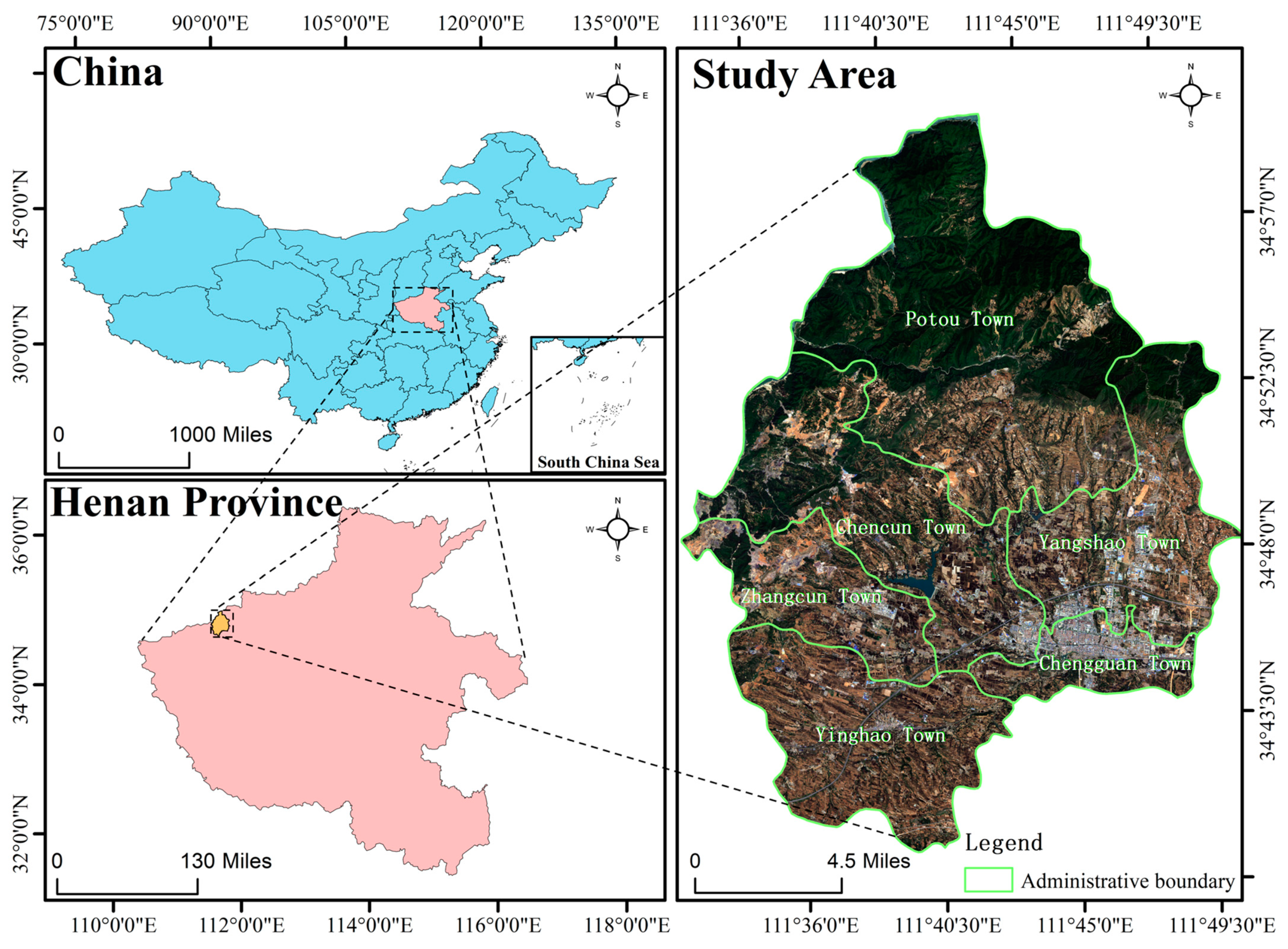


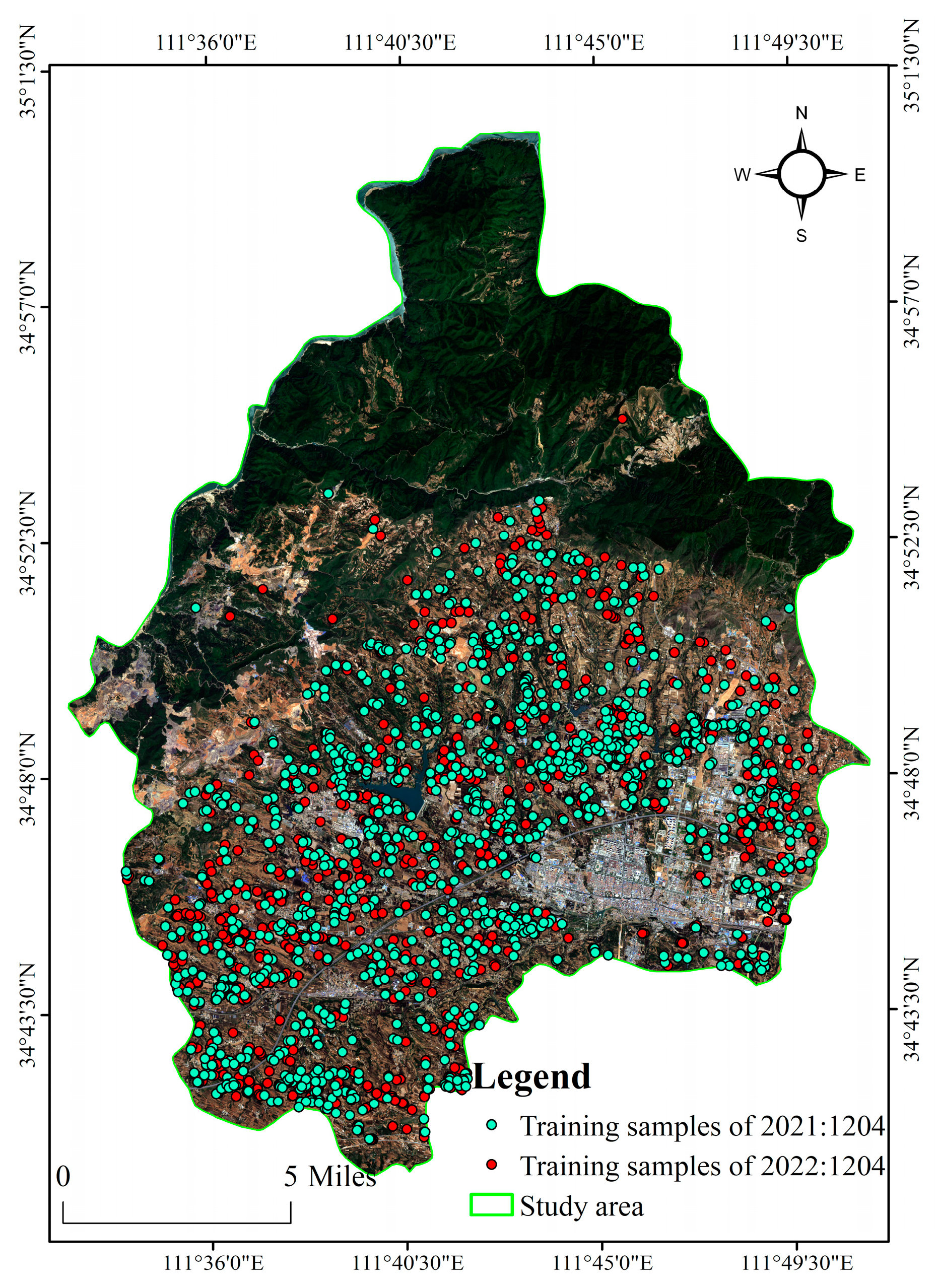
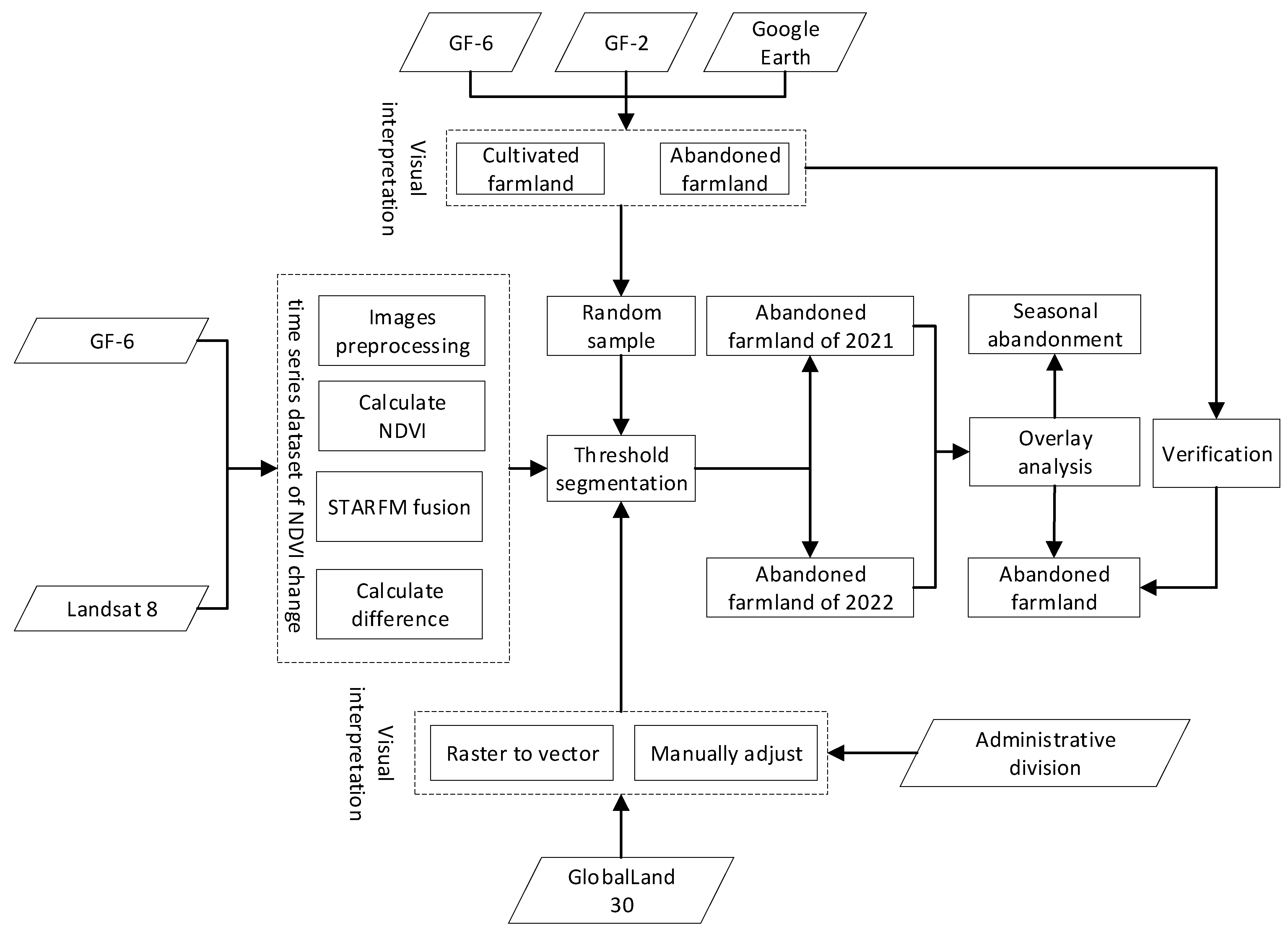




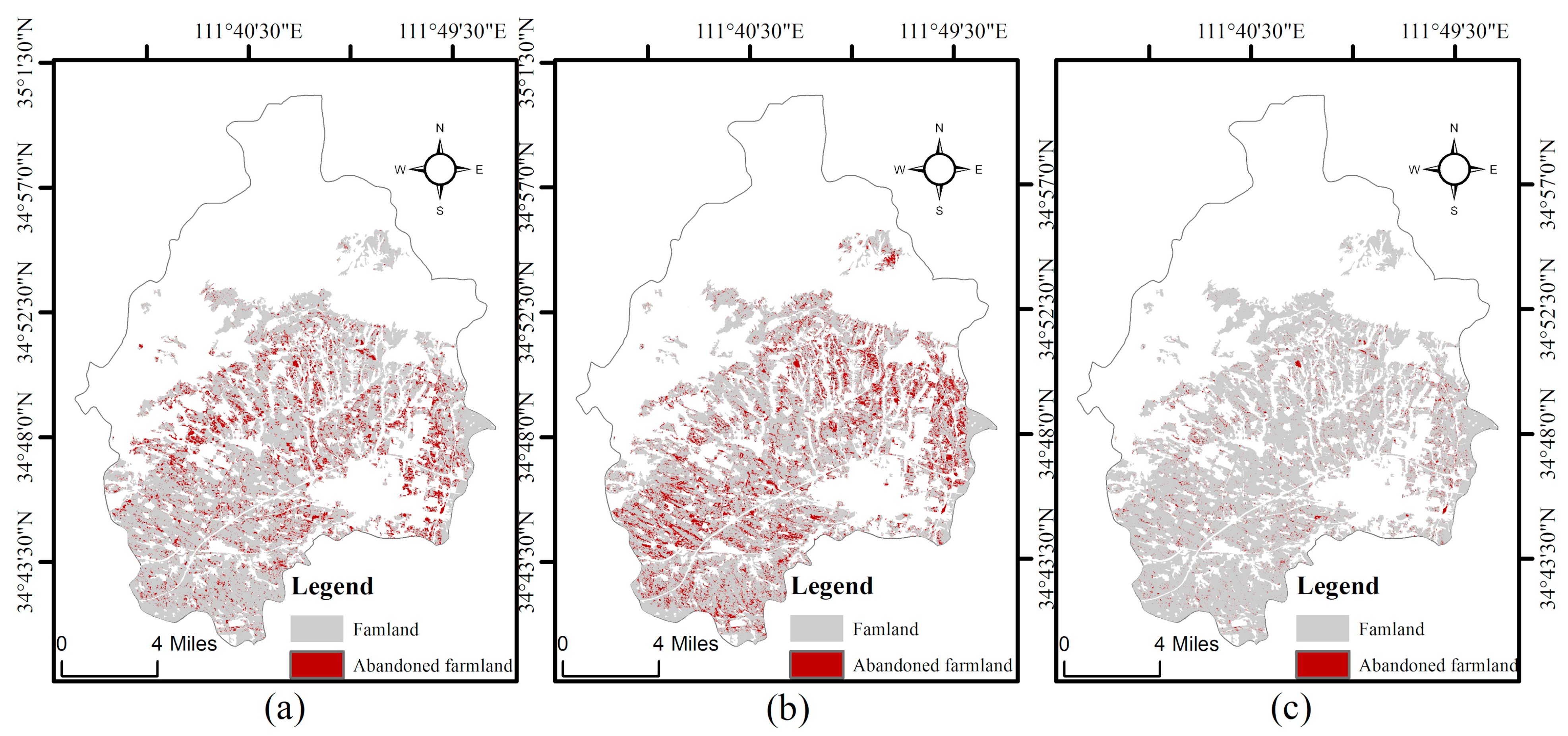
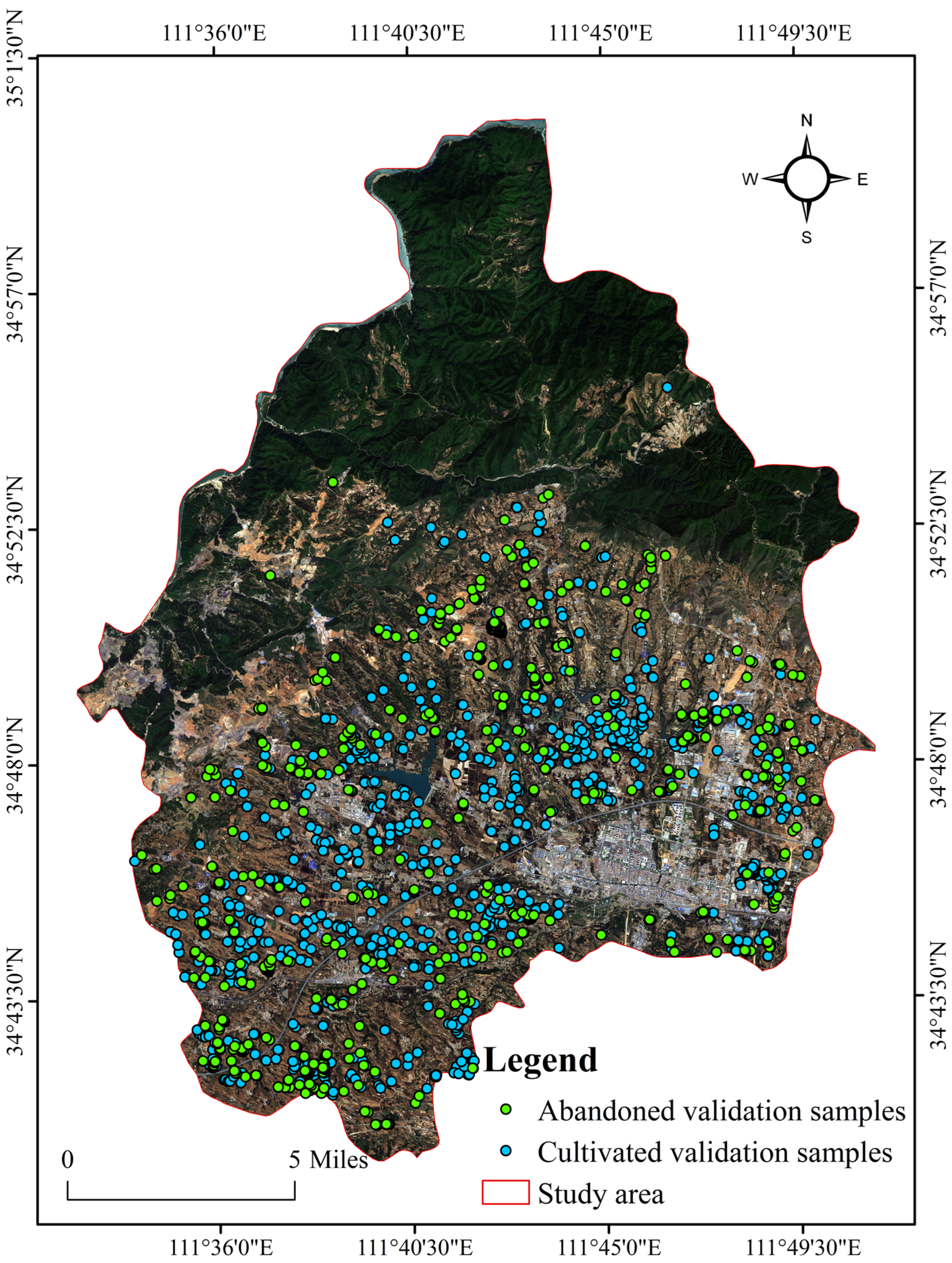

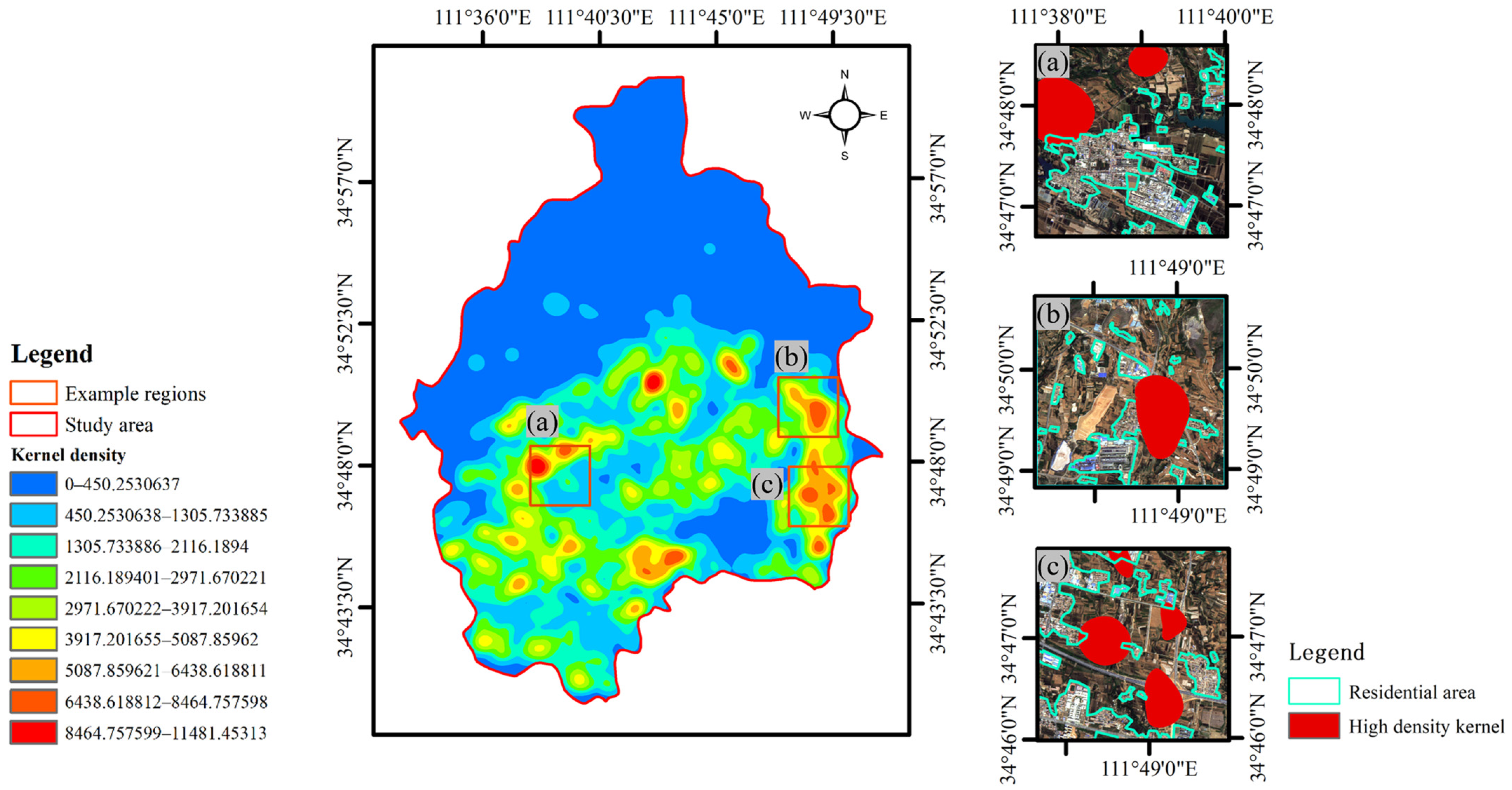
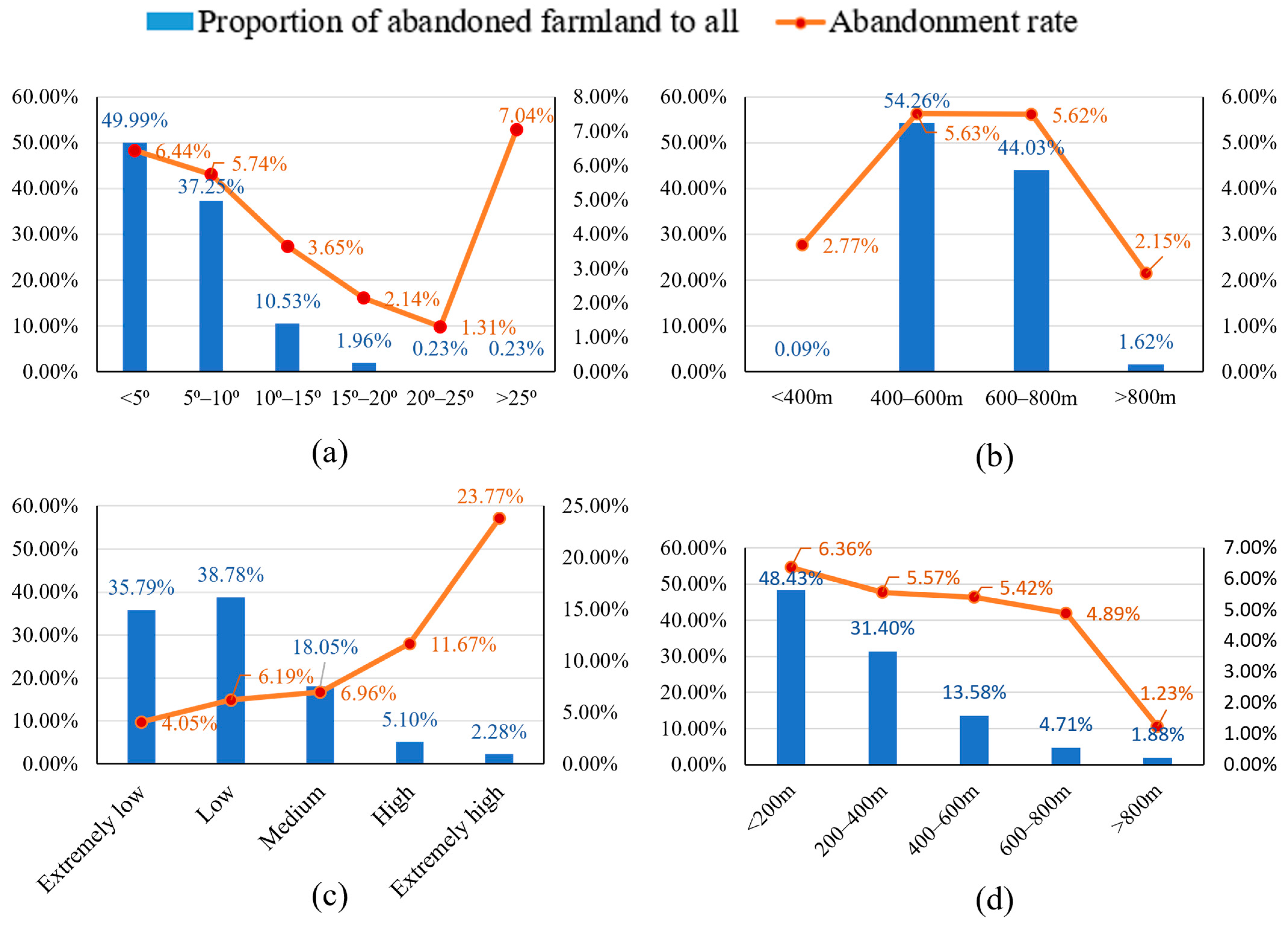
| Feature | Landsat 8 | GF-6 | GF-2 | Google Earth | ALOS |
|---|---|---|---|---|---|
| Data type | Remote-sensing data | DEM | |||
| Altitude (km) | 705 | 645 | 631 | 692 | |
| Number of bands | 11 | PAN:8 MS:2 | PAN:4 MS:1 | ||
| Temporal resolution (d) | 16 | 41 | 69 | 14 | |
| Spatial resolution (m) | 30 | PAN:2 MS:8 | PAN:1 MS:4 | 0.6 | 12.5 |
| Band/wavelength (μm) | B4/Red: 0.64–0.67 | B3/Red: 0.63–0.69 | |||
| B5/NIR: 0.85–0.88 | B4/NIR: 0.76–0.90 | ||||
| MS: 0.45–0.90 | MS: 0.45–0.90 | ||||
| Number of Polygons | Average Area | Minimum Area | Maximum Area | Median Area |
|---|---|---|---|---|
| 193 | 1.24 km2 | 5.02 × 10−4 km2 | 191.75 km2 | 0.25 km2 |
| Date of GF-6 NDVI | Date of Landsat 8 NDVI | Date of STARFM-Fused NDVI |
|---|---|---|
| 11 June 2021 | 14 June 2021 | 30 April 2021 |
| 26 November 2021 | 26 November 2021 | 21 September 2021 |
| 26 November 2022 | 26 November 2022 | 10 October 2022 |
| Year of Time Series Dataset | Date of GF-6 | Date of STARFM-Fused Data |
|---|---|---|
| 2021 | 25 March | 30 April |
| 26 November | 21 September | |
| 2022 | 24 February | |
| 5 May | 10 October | |
| 1 July | ||
| 26 November |
| Analysis Method | Dataset | Overall Accuracy | Kappa Coefficient |
|---|---|---|---|
| NDVI difference | GF-6 dataset | 78.93% | 0.58 |
| NDVI difference | Fusion dataset 1 | 93.43% | 0.87 |
| NDVI difference | Landsat dataset | 64.91% | 0.30 |
| SVM | Fusion dataset | 83.94% | 0.68 |
| Feature | Range | Farmland Area/km2 | Cultivation Area/km2 | Abandonment Area/km2 | Abandonment Rate/% |
|---|---|---|---|---|---|
| Elevation | <400 m | 0.42 | 0.41 | 0.01 | 2.77 |
| 400–600 m | 122.66 | 115.75 | 6.91 | 5.63 | |
| 600–800 m | 99.75 | 94.14 | 5.61 | 5.62 | |
| >800 m | 9.58 | 9.37 | 0.21 | 2.15 | |
| Slope | 0–5° | 98.81 | 92.45 | 6.36 | 6.44 |
| 5–10° | 82.55 | 77.81 | 4.74 | 5.74 | |
| 10–15° | 36.71 | 35.37 | 1.34 | 3.65 | |
| 15–20° | 11.66 | 11.41 | 0.25 | 2.14 | |
| 20–25° | 2.26 | 2.23 | 0.03 | 1.31 | |
| >25° | 0.42 | 0.39 | 0.03 | 7.04 | |
| Distance to residential area | 0–200 m | 96.94 | 90.77 | 6.17 | 6.36 |
| 200–400 m | 71.82 | 67.82 | 4.00 | 5.57 | |
| 400–600 m | 31.94 | 30.21 | 1.73 | 5.42 | |
| 600–800 m | 12.26 | 11.66 | 0.60 | 4.89 | |
| >800 m | 19.45 | 19.21 | 0.24 | 1.23 | |
| Road density | Extremely low | 112.73 | 108.17 | 4.56 | 4.05 |
| Low | 79.85 | 74.91 | 4.94 | 6.19 | |
| Medium | 33.04 | 30.74 | 2.30 | 6.96 | |
| High | 5.57 | 4.92 | 0.65 | 11.67 | |
| Extremely high | 1.22 | 0.93 | 0.29 | 23.77 |
Disclaimer/Publisher’s Note: The statements, opinions and data contained in all publications are solely those of the individual author(s) and contributor(s) and not of MDPI and/or the editor(s). MDPI and/or the editor(s) disclaim responsibility for any injury to people or property resulting from any ideas, methods, instructions or products referred to in the content. |
© 2024 by the authors. Licensee MDPI, Basel, Switzerland. This article is an open access article distributed under the terms and conditions of the Creative Commons Attribution (CC BY) license (https://creativecommons.org/licenses/by/4.0/).
Share and Cite
Deng, J.; Guo, Y.; Chen, X.; Liu, L.; Liu, W. Abandoned Farmland Extraction and Feature Analysis Based on Multi-Sensor Fused Normalized Difference Vegetation Index Time Series—A Case Study in Western Mianchi County. Appl. Sci. 2024, 14, 2102. https://doi.org/10.3390/app14052102
Deng J, Guo Y, Chen X, Liu L, Liu W. Abandoned Farmland Extraction and Feature Analysis Based on Multi-Sensor Fused Normalized Difference Vegetation Index Time Series—A Case Study in Western Mianchi County. Applied Sciences. 2024; 14(5):2102. https://doi.org/10.3390/app14052102
Chicago/Turabian StyleDeng, Jiqiu, Yiwei Guo, Xiaoyan Chen, Liang Liu, and Wenyi Liu. 2024. "Abandoned Farmland Extraction and Feature Analysis Based on Multi-Sensor Fused Normalized Difference Vegetation Index Time Series—A Case Study in Western Mianchi County" Applied Sciences 14, no. 5: 2102. https://doi.org/10.3390/app14052102
APA StyleDeng, J., Guo, Y., Chen, X., Liu, L., & Liu, W. (2024). Abandoned Farmland Extraction and Feature Analysis Based on Multi-Sensor Fused Normalized Difference Vegetation Index Time Series—A Case Study in Western Mianchi County. Applied Sciences, 14(5), 2102. https://doi.org/10.3390/app14052102






